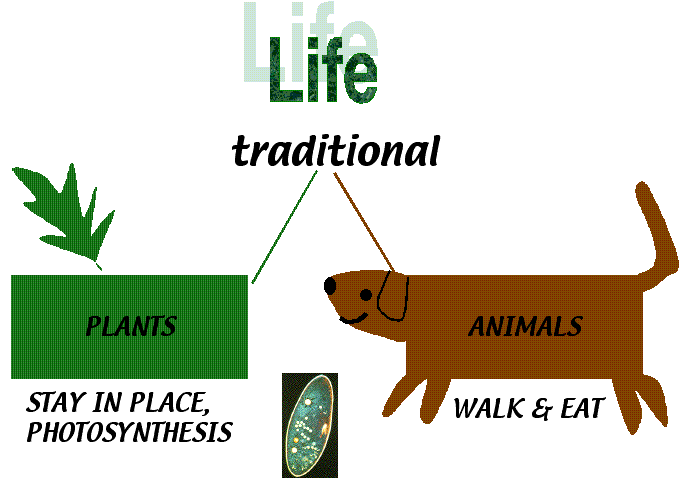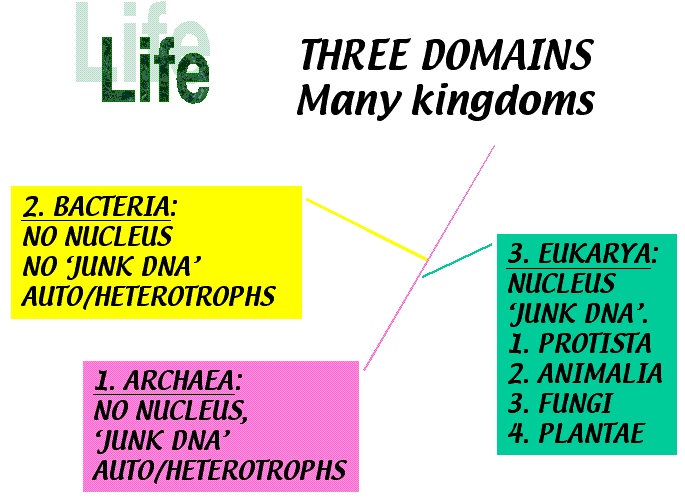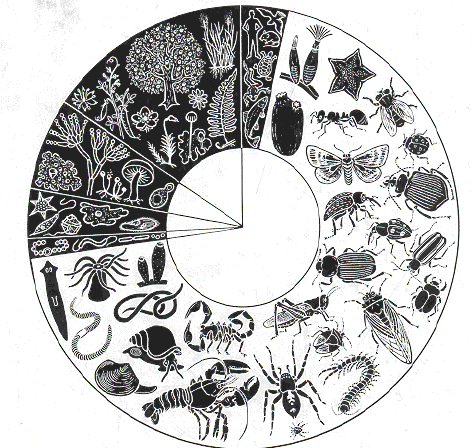

Building Plans of Organisms.
1. Life: how is it classified?
1.
Life: how is it classified?
We subdivide living things on Earth either by their family relations ships, or by their function in ecosystems.
Life subdivided by its function:
Note that all living things on Earth depend on the producers to make the first step from inorganic to organic material, and these producers include plants, but also bacteria and unicellular algae (protists - see below). Note also that PRODUCERS and DECOMPOSERS are needed and sufficient to run a system over long periods of time: a system made up of producers and decomposers recycles its materials and thus can persist for long times. Note that consumers (including we), however, are superfluous.
Remember this one reaction, the reaction of photosynthesis (goes left to right), and its reverse, the reaction of rotting-respiration (goes right to left)):
in which H2O is water, CO2 carbon dioxide, CH2O a short-hand, very simplified way of describing organic matter, and O2 is oxygen gas. Note that the reaction can go either left to right (given by ->), in which way it describes the reaction of photosynthesis (making organic matter from inorganic components using the energy from sunlight), or right to left (given by <-), in which way it describes such processes as rotting of organic matter or breathing.
Life subdivided by its
relations:
Originally (in the eighteenth century and earlier), life on earth was subdivided into two kingdoms: plants (stay in place, photosynthesize) and animals (move and eat).

It turned out that this subdivision does not really work out for many unicellular organisms, which may photosynthesize and eat and move around. Fungi do stay in place but do not photosynthesize, and have now been shown to have a closer affinity in their genetic makeup to animals than to plants. Then it became popular to recognize 5 kingdoms, roughly from the 1960s through the 1990s. Now most scientists recognize 3 domains and many kingdoms. Note that what is placed in this figure in Protista within the Domain Eukarya is now usually split up into about 20 separate kingdoms, which each are as different from each other as cows are from mushrooms.

Archaea are unicellular, have no cell nucleus, can be autotrophs or heterotrophs; can perform photosynthesis or chemosynthesis; and their DNA contains both exons (parts of DNA that code for proteins) and introns (junk DNA, of which we do not know the function, but it does not code for proteins).
Bacteria are likewise unicellular, have no cell nucleus, may be autotrophs or heterotrophs; may perform photosynthesis and chemosynthesis; but their DNA has exons only. Note that Archaea and Bacteria together were grouped into the 'Monera' or Prokaryotes; now it has been realized that there are differences between these two groups that are as large as between these and the other groups of organisms (i.e., an Archae is as fundamentally different from a Bacteria although both look like little blobs to us as a Bacteria is from an oak tree or from us).
Note the absence of viruses. Viruses are NOT monophyletic (i.e., they are not all descended from the same ancestor, and thus do NOT all belong to the same kingdom or even domain). Some should be included in the Bacteria, some in the Archaea, some in the protists, some in the fungi. The apparent simplicity of viruses is thus not seen as original and primitive; viruses are seen as descendants of more complex organisms, which became simpler because of their parasitic life style.
Bacteria and Archaea both existed by 3.5 Ga ago (Ga = billion years); because both Archaea and Eukaryotes have both introns and exons, these two groups are seen as most closely related to each other.
Much research, both paleontological and molecular biological, has been put into trying to reconstruct a universal Tree of Life, showing the relationships between the domains and within the domains.
The largest units of subdivision of the Kingdoms are called Phyla (singular: Phylum; plural: Phyla). A Phylum is a large group of organisms that shares the same general building plan. Phyla are in many cases not very familiar units to use, although some are. Vertebrata (animals with a backbone), for instance, including we, are not a Phylum by themselves; together with several less familiar groups they form the Phylum Chordata. The Phylum Mollusca is similar to the vernacular word mollusks; it includes snails (Gastropoda), Bivalvia (bivalves: mussels and clams and so), but also lesser know groups such as the Nautilus and the extinct ammonites. The Phylum Arthropoda is very large, and includes insects and lobsters and spiders, as well as the extinct trilobites. The Phylum Porifera includes all sponges.
The classification of most of the larger Phyla has been stable for a long time, and there is considerable agreement between fossil data and genetic data, but there are many discussions regarding the smaller Phyla. Land-dwellers such as we see usually not many Phyla of animals in our daily life: most animals that we meet are either Chordata (all mammals, birds, reptiles, amphibians and fish), Arthropoda (all insects and spiders), Mollusca (snails, slugs) or Annelida (worms). Although there are very many more species of animals on land as in the oceans, marine animals represent many more basically different building plans (i.e., Phyla).
In the present oceans the most common animals (even leaving out the rare ones) belong to many more Phyla than the animals on land. These include the Chordates (fish and marine mammals and reptiles), Mollusca (life forms with two shells,such as clams, mussels; but also snails; and squid and octopus); Arthropods (lobsters and shrimp; horseshoe crab), Cnidaria (sea anemones, corals and jellyfish), Porifera (sponges), Echinodermata (sea urchins, star fish, brittle stars, sea cucumbers), and several different phyla that all look like worms.
Note that from all described species animals are the most common group of Phyla (white background in figure below). Of course, invertebrate animal species far outnumber vertebrate animals: about 97% of all species of animals are invertebrates. The most species-rich Phylum is the Arthropoda, followed by the Mollusca. Remember, however, that we do not really have a good definition of what is 'a species' for the prokaryotes (Domains Bacteria and Archaea), and that these domains may very well much more diverse than we estimate now. Similalry, the various kingdoms that were formerly lumped in the Protista (unicellular eukaryotes) are not well described and this group may be much more diverse than thought now. But it is certain that we also do not know by far how many insect species there are on the world.

Title page of 'Living Invertebrates', V. Pearse, J. Pearse, M. Buchsbaum, R. Buchsbaum, 1987, Blackwell Scientific Publications.
Animals are subdivided on their types of tissues and body
cavities. Sponges behave still a bit like a colony of
single-celled organisms, in which the cells have not really become
organized into organs; they are seen as the most primitive
Phylum, and have basically only one type of cell. The next
group are the corals, sponges and jellyfish (Cnidaria), which have
two types of cells that are clearly different from each other,
and a gelatinous layer in between, but they have no organization
of tissues into organs. The next group, the flat worms
(Platyhelminthes), have three types of tissues in their body,
but no spaces (body cavity or coelom) in between (i.e., no place for
blood as we know it, or a respiratory set of organs). They are seen
as the ancestral group for most other Phyla, which all have body
cavities.
Points to remember: